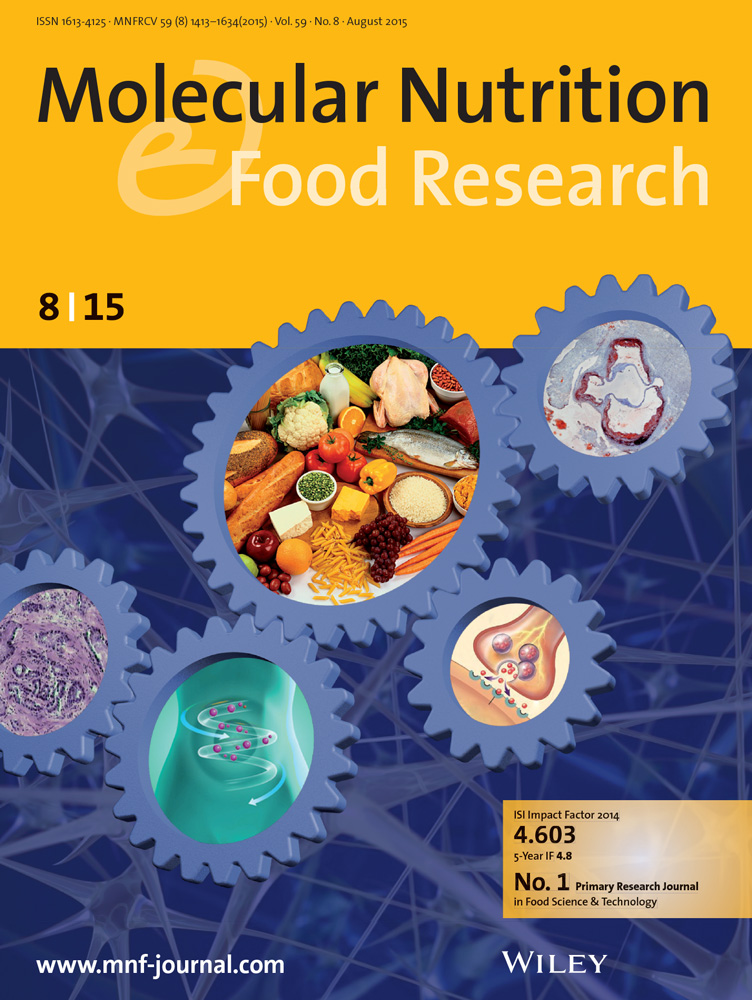富含生物活性化合物的特级初榨橄榄油对Apoe缺乏小鼠动脉粥样硬化的影响
IF 4.2
2区 农林科学
Q1 FOOD SCIENCE & TECHNOLOGY
引用次数: 0
摘要
为了测试富含特定生物活性化合物(EVOO HBC)的特级初榨橄榄油(EVOO)对动脉粥样硬化和脂肪肝的影响,将三种脂肪类型不同的等热量西方饮食(棕榈、EVOO或EVOO HBC)喂给Apoe‐缺乏的小鼠12周。定量测定血浆脂质、脂蛋白特征、循环CD36表达单核细胞和M2腹腔巨噬细胞。分析肝角鲨烯、横断面和表面动脉粥样硬化病变。与棕榈组相比,两组小鼠血浆甘油三酯和葡萄糖水平升高,APOA1、对氧磷酶1活性和脂蛋白氧化降低。后者根据消耗量储存肝角鲨烯。EVOO组的表面和横断面动脉粥样硬化病变较低。EVOO组循环单核细胞CD36表达较低,M2腹腔巨噬细胞表达较高。在男性中,动脉粥样硬化斑块中表达CD68的细胞减少,而在女性中,面部病变减少,与高密度脂蛋白(HDL) -磷脂外排负相关。巨噬细胞向动脉粥样硬化斑块的募集和HDL外排的改善可能是性别依赖的,归因于高含量的角鲨烯和特定的橄榄苦苷元。本文章由计算机程序翻译,如有差异,请以英文原文为准。
Effect of Extra Virgin Olive Oil High in Bioactive Compounds on Atherosclerosis in Apoe‐Deficient Mice
To test the effects of extra virgin olive oil (EVOO) enriched in specific bioactive compounds (EVOO HBC) on atherosclerosis and fatty liver, three isocaloric Western diets differing in the type of fat (palm, EVOO, or EVOO HBC) were fed to Apoe ‐deficient mice for 12 weeks. Plasma lipids, lipoprotein characterization, circulating CD36‐expressing monocytes, and M2 peritoneal macrophages were quantified. Hepatic squalene and cross‐sectional and en face atherosclerotic lesions were analyzed. Compared to the palm group, plasma triglyceride and glucose levels increased, while APOA1, paraoxonase 1 activity, and lipoprotein oxidation decreased in mice fed both EVOO groups. The latter stored liver squalene according to the amount consumed. En face and cross‐sectional atherosclerotic lesions were lower in the EVOO groups. CD36 expression in circulating monocytes was lower and M2 peritoneal macrophages were higher in the EVOO groups. In males, there was a reduced presence of CD68‐expressing cells in atherosclerotic plaques, while in females, there was a reduction in en face lesions that negatively correlated with high‐density lipoprotein (HDL)‐phospholipid efflux. The recruitment of macrophages into atherosclerotic plaques and the improvement of HDL efflux may be sex‐dependent and attributable to the high content of squalene and a specific oleuropein aglycone.
求助全文
通过发布文献求助,成功后即可免费获取论文全文。
去求助
来源期刊

Molecular Nutrition & Food Research
工程技术-食品科技
CiteScore
8.70
自引率
1.90%
发文量
250
审稿时长
1.7 months
期刊介绍:
Molecular Nutrition & Food Research is a primary research journal devoted to health, safety and all aspects of molecular nutrition such as nutritional biochemistry, nutrigenomics and metabolomics aiming to link the information arising from related disciplines:
Bioactivity: Nutritional and medical effects of food constituents including bioavailability and kinetics.
Immunology: Understanding the interactions of food and the immune system.
Microbiology: Food spoilage, food pathogens, chemical and physical approaches of fermented foods and novel microbial processes.
Chemistry: Isolation and analysis of bioactive food ingredients while considering environmental aspects.
 求助内容:
求助内容: 应助结果提醒方式:
应助结果提醒方式:


